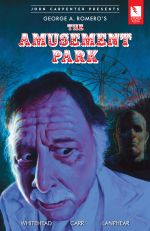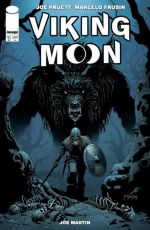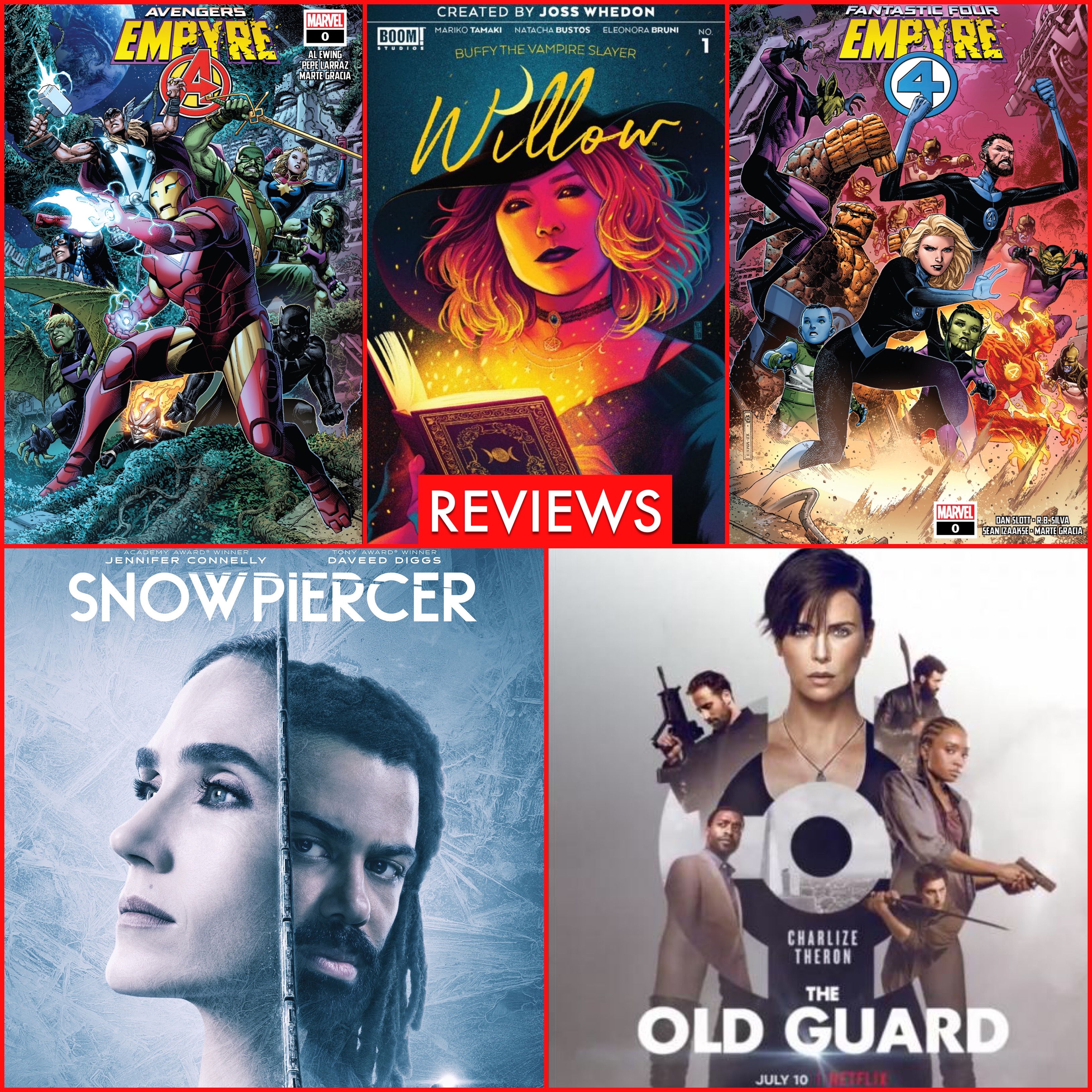JEFF WHITEHEAD
 SEND THIS TO A FRIEND! SEND THIS TO A FRIEND!
DF Interview: Author Jeff Whitehead and two cinematic horror icons come together for new graphic novel ‘The Amusement Park’ By Byron Brewer William Lincoln, an impatient businessman in his 20s, meets an elderly man in a coffee shop that was once the grounds of a sprawling amusement park. As their conversation progresses, Lincoln soon understands that rather than a normal amusement park centered around family fun, this park is a surreal world of horrors where every attraction is a simulation of aging and elder abuse culminating in a downward spiral toward certain death. The Amusement Park, George A. Romero’s groundbreaking, 45-minute “lost” film from 1975, becomes a graphic novel this spring when Storm King Comics releases John Carpenter Presents George A. Romero’s The Amusement Park, an all-new artistic interpretation of the unique film. Long thought to be lost, and originally conceived as a public service announcement, The Amusement Park is a surreal, haunting commentary on ageism and society’s treatment of the elderly, wrapped in Romero’s signature horror style. The George A. Romero Foundation, which is dedicated to honoring the life and preserving Romero’s work, restored the film as one of its first projects, and discovered the result met with widespread critical acclaim. As critics and audiences pored through the myriad of images and meanings found in The Amusement Park, the Foundation and its artist-in-residence, illustrator Ryan Carr, began working on adapting the film in a novel way—a graphic novel way! Along with writer Jeff Whitehead, a visually stunning interpretation of the film came to life on the page. And when I saw that two of the greatest names in cinematic horror – John Carpenter and George A. Romero – were a part of this, you can bet that I was on board. And I had the chance to sit down with scribe Jeff Whitehead to discuss this most unique project. Byron Brewer: Jeff, you are working on a graphic novel whose title banners carry two of the most iconic names in horror: John Carpenter and George A. Romero. How does it feel to be on the shoulders of giants and how did you first get involved in the making of The Amusement Park GN? Jeff Whitehead: The first time I showed the cover to a friend, he said, 'You know, your name is right there with George Romero and John Carpenter.' It gave me chills. It is a tremendous honor and privilege to have collaborated with Sandy, John, and Sean Sobczak from Storm King Comics to bring this book to life. And of course, Ryan Carr, with whom I've now worked with quite a bit, created the masterful artwork throughout. He is a wizard with lines and colors. I am the Chief of Operations for the George A. Romero Foundation, but I came to that post through the network of people I had met through writing projects. While we were restoring the film, Suz and I started talking about how we could bring the piece to new audiences. Through the restoration process, I noticed where the filmmakers had to make concessions for budget, time and resources. I suggested that we adapt it to a graphic novel to free us from those constraints. We had several development meetings on how it should look and feel, then I dove into the job of adapting the work of a titan. And I loved every minute of it. Byron: Before we deep dive into your book, tell readers about the “lost” Romero film which shares its name with the GN. What was it about, how did it get “lost” and later “found”? Jeff Whitehead: The film was originally commissioned by the Lutheran Service Society of Western Pennsylvania as a public service announcement against elder abuse. George, Wally Cook, and Lincoln Maazel combined forces to create something much more avant garde than the Lutheran Society was expecting. After its festival premiere at the American Film Festival in New York, it received a couple of local television spots before it was shelved. There is only evidence of a screening or two at small theaters that managed to get their hands on one of the 16mm prints in the decades that followed. When George passed, one of the 16mm prints passed to Suzanne Romero, the Founder and President of the George A. Romero Foundation. She had the vision to restore the film so that the general public could see this seldom-seen and highly underappreciated piece of George's oeuvre. Although it is not a horror film, it is an important piece of George's legacy as it connects some of his early work with his later pieces and continues his desire to produce socially conscious films. Byron: Introduce us to your two main protagonists, a young businessman and an elderly gentleman. Can you give any non-spoiler details of their lives, and how those might be in juxtaposition to each other? Jeff Whitehead: Our two characters meet in a coffee shop. In real life, this coffee shop is a composite of places that actually exist on the grounds where West View Park once stood. Without any spoilers, our young businessman is lost while pursuing wealth and power. He wishes time would move faster so that he could reach the top of the mountain. He makes an offhand comment about a carousel horse outside the coffee shop (which is really there, by the way), and the elderly gentleman asks if he wishes to learn more about the amusement park that once stood there. The elderly gentleman is at peace with being toward the end of his life, enjoying the sunshine, a good cup of coffee, and a long story. The young businessman is drawn in for what he hopes is a brief explanation. It ends up being much more. Byron: Give readers unfamiliar with Romero’s film an overall look at this graphic novel. Again without spoilers, an expanded elevator pitch, if you will. Jeff Whitehead: The graphic novel is about aging and its trials and tribulations. George and Wally recognized while making the film that our only true villain is Father Time. The Amusement Park chronicles what might occur toward the end of life, the horrors of watching your body and mind fail, the mistreatment at the hands of those who are trying to cheat you, and a lack of understanding and appreciation for the experience that you bring to bear. I think George's most effective films are those that speak to societal problems, and The Amusement Park certainly does that. Each amusement park ride and activity becomes an allegory for the aging process. Byron: I understand the Amusement Park book is also a tribute to Romero’s enduring influence on the horror genre. Expound on that please. Jeff Whitehead: Everything we do as a Foundation is in George's honor and memory. As I have alluded to, in my opinion, the most important aspect of George's enduring horror legacy is not the horror itself. George was able to spin a tale that simultaneously horrified and made the audience think. He addressed societal problems of the time, but also timeless issues such as that which he explored in The Amusement Park, the inevitability of aging and death. Byron: Was it difficult to adapt a cult-loved film by a giant in the industry under watchful eyes of people working for a second genre giant? What part of Amusement Park best represents the lens through which illustrator Ryan Carr and yourself view it? Jeff Whitehead: It was actually a lot of fun. George and Wally provided a great blueprint, and our friends Sandy and Sean at Storm King gave us the flexibility to tell the story in a way that we all hope would have made George very proud. Ryan and I spent countless hours pining over panels, angles, bits of dialogue, and where we needed to shave or augment to drive a cohesive story that felt less like a public service announcement and more like a nightmarish urban fantasy. Byron: Speaking of Ryan Carr, the artist here has a unique history with this project. Can you touch on that and also discuss your collaboration on the book? Jeff Whitehead: Ryan is an enormously talented rock star of an artist. We brought him in as an artist-in-residence for the George A. Romero Foundation years ago. He did several projects with us, and we then started talking about the idea of adapting The Amusement Park to graphic novel. He was in from the beginning, working on some concept art long before we started drafting pages. Ryan struck the balance between paying homage to the style in which the film was made with a beautiful and often surreal artistic flair and color palette. We communicated a ton, daily during the heaviest stretch of art. He'd make great suggestions on how to reframe some of my initial panel ideas and was incredibly receptive to my ideas on the art. It was a terrific partnership, and I'll look forward to working with Ryan on projects for years to come. Byron: Jeff, what other of your projects are upcoming that you can tell readers about? Jeff Whitehead: I love to write, I'm always eager to have a wide range of projects on which to work. I am currently writing two podcasts for BloodyFM, Poe Evermore that I created with producer Pacific Obadiah, and Creepy Places hosted by Jon Grilz. Poe Evermore is an historical fantasy that blends Edgar Allan Poe's life with those of his characters to create a world in which he is deriving inspiration for his tales through his own experiences. Ryan has done all of the incredible cover art for each episode of that as well! Creepy Places is a podcast at the intersection of true crime and the supernatural. I've also been writing and producing short and feature films which are in various stages of production and distribution. I'm really excited to continue collaborating on graphic novels with Ryan. We have a ton of very cool ideas, some adaptations, some originals that we're ready to produce and get out there to the world. Ryan and I have a graphic novel dream project in mind as well, one that would adapt another piece of George's work, but from an early draft of what became one of his most socially-conscious and important films. Dynamic Forces would like to thank Jeff Whitehead for taking time out of his busy schedule to answer our questions. The graphic novel John Carpenter Presents George A. Romero’s The Amusement Park from Storm King Comics is slated to be on sale May 7!
NEW! 1. 08/26/2025 - JOE PRUETT2. 08/20/2025 - CHRISTIAN WARD 3. 08/13/2025 - JORDAN THOMAS 4. 08/05/2025 - RAVI TEIXEIRA 5. 07/23/2025 - SEAN PHILLIPS Show All |







